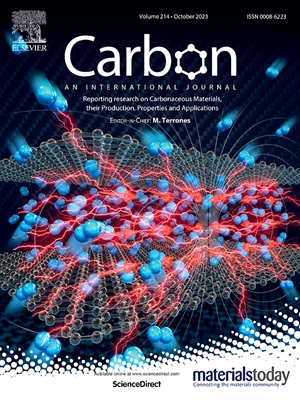磷转移诱导的碳层自愈精确调节硬碳缺陷和封闭孔隙
IF 11.6
2区 材料科学
Q1 CHEMISTRY, PHYSICAL
引用次数: 0
摘要
硬碳是一种很有前途的钠离子电池负极材料。然而,闭孔结构的精确设计和碳缺陷的控制仍然是聚合物衍生硬碳发展的关键瓶颈。基于此,本文提出了磷(P)转移诱导碳层自愈策略,实现了闭孔结构与碳缺陷的协同优化。通过预氧化介导的边界磷(P-O-C)向碳基质磷(P-C)的转移途径,在热解过程中引发自由基竞争反应,将厚而短的无序碳层转化为薄而长的伪石墨碳层。该策略在碳基体中构建了丰富且均匀分布的小尺寸封闭孔隙(0.76 nm),将不规则的边缘碳缺陷转化为内生性碳缺陷。两者的协同优化促进了富氟固体电解质界面组分的形成,显著增强了Na+输运动力学。优化后的硬碳具有高达429.0 mAh g−1的可逆比容量,高达89.44%的初始库仑效率(ICE),以及在5 a g−1电流密度下的优异循环性能,可实现10000次循环。该研究为高性能聚合物衍生硬碳材料的开发提供了新的途径。本文章由计算机程序翻译,如有差异,请以英文原文为准。

Phosphorus-transfer-induced self-healing of carbon layers for precise modulation of hard carbon defects and closed pores
Hard carbon (HC) is a promising anode material for sodium-ion batteries. However, the precise design of closed-pore structures and the control of carbon defects remain key bottlenecks in the development of polymer-derived hard carbon. Based on this, this paper proposes a phosphorus (P)-transfer-induced carbon layer self-healing strategy, achieving synergistic optimization of closed-pore structures and carbon defects. Through a pre-oxidation-mediated transfer pathway of boundary phosphorus (P–O–C) to carbon matrix phosphorus (P–C), radical competitive reactions are triggered during pyrolysis, transforming thick and short disordered carbon layers into thin and long pseudo-graphitic carbon layers. This strategy constructs abundant and uniformly distributed small-sized closed pores (0.76 nm) in the carbon matrix while converting irregular edge carbon defects into intrinsic carbon defects. The synergistic optimization of both promotes the formation of fluorine-rich solid electrolyte interface components, significantly enhancing Na+ transport kinetics. The optimized hard carbon exhibits a reversible specific capacity of up to 429.0 mAh g−1, an initial coulombic efficiency (ICE) of up to 89.44 %, and excellent cycling performance at a current density of 5 A g−1, enabling 10000 cycles. This study provides a new approach for the development of high-performance polymer-derived hard carbon materials.
求助全文
通过发布文献求助,成功后即可免费获取论文全文。
去求助
来源期刊

Carbon
工程技术-材料科学:综合
CiteScore
20.80
自引率
7.30%
发文量
0
审稿时长
23 days
期刊介绍:
The journal Carbon is an international multidisciplinary forum for communicating scientific advances in the field of carbon materials. It reports new findings related to the formation, structure, properties, behaviors, and technological applications of carbons. Carbons are a broad class of ordered or disordered solid phases composed primarily of elemental carbon, including but not limited to carbon black, carbon fibers and filaments, carbon nanotubes, diamond and diamond-like carbon, fullerenes, glassy carbon, graphite, graphene, graphene-oxide, porous carbons, pyrolytic carbon, and other sp2 and non-sp2 hybridized carbon systems. Carbon is the companion title to the open access journal Carbon Trends. Relevant application areas for carbon materials include biology and medicine, catalysis, electronic, optoelectronic, spintronic, high-frequency, and photonic devices, energy storage and conversion systems, environmental applications and water treatment, smart materials and systems, and structural and thermal applications.
 求助内容:
求助内容: 应助结果提醒方式:
应助结果提醒方式:


